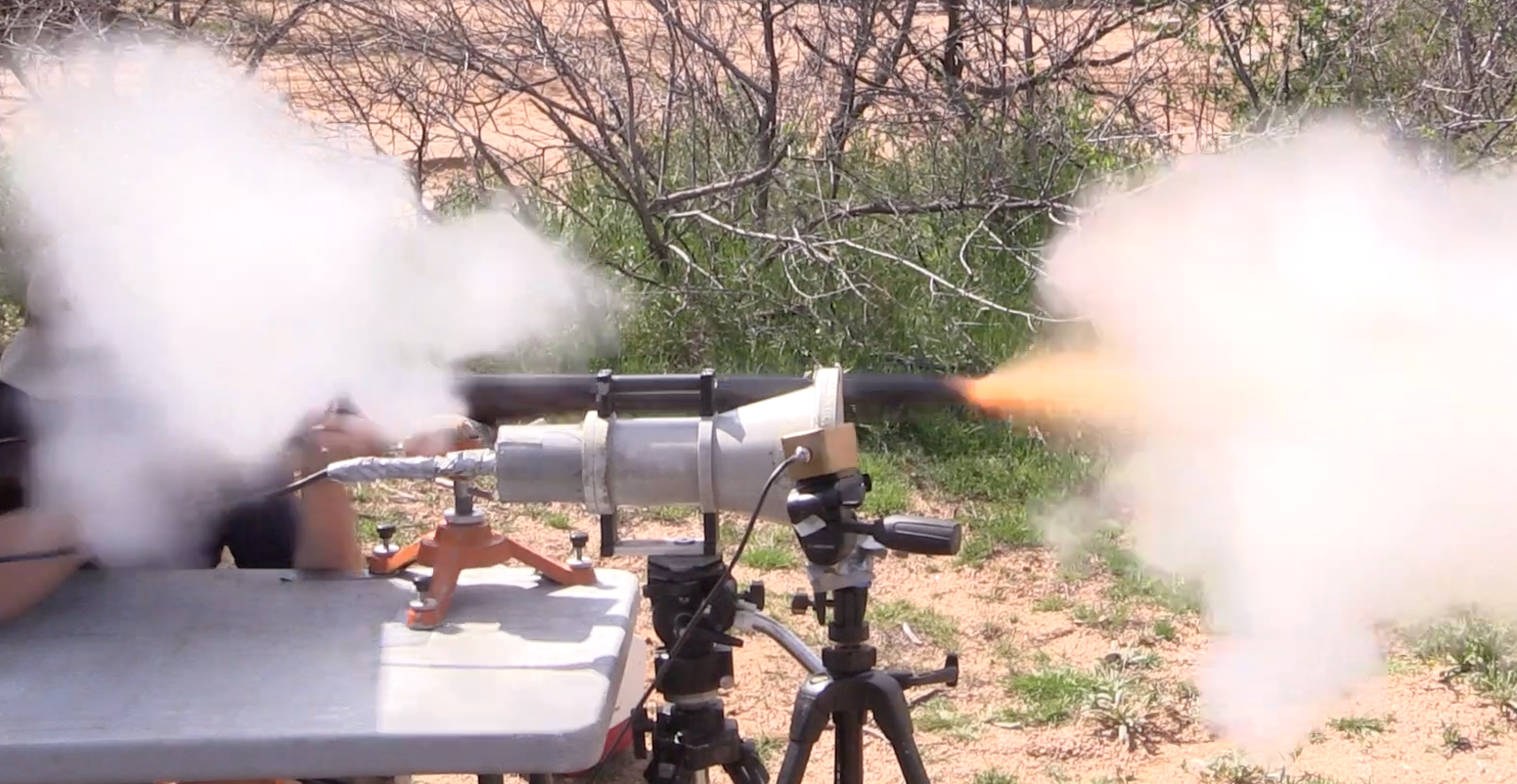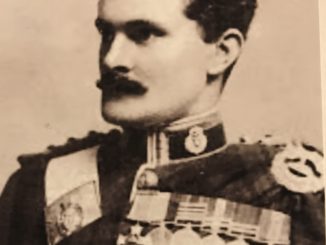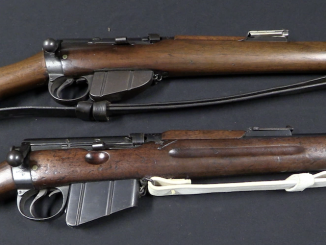The Nock Volley Gun was actually invented by an Englishman named James Wilson in 1789, and presented to the British military as a potential infantry weapons. This was declined as impractical, but the Royal Navy found the concept interesting for shipboard use. In 1790 the Navy ordered two prototypes made by the British gunsmith Henry Nock, and finding them suitable, proceeded to oder a total of 500 of the guns (thus forever associating Nock’s name with the gun instead of Wilson’s). A further 100 or so were ordered in 1797, and the guns were in fact issued out to various ships – although accounts of their use in combat are difficult to find.
Unfortunately for Nock, the guns presented a couple substantial problems in use. One was simply the recoil of firing. A single 32-bore (approximately .55 caliber) round ball over 40 grains of black powder is not a very impressive load, but seven of them firing simultaneously add up to a recoil comparable to 4- or 6-bore rifles, and in a volley gun weighing just 13 pounds (5.9kg). In addition, the guns did not always reliably fire all barrels, especially when dirty. This produced a conundrum: how to determine which barrels had fired and which had not? The practical result was double-loaded barrels, which could be liable to bulge or burst. For these reasons, the weapon was declared obsolete in 1805, and never appeared to play any significant military role.
The gun did receive a new wave of popular awareness in 1960, when the character of Jim Bowie was outfitted with one in the movie “The Alamo” (against all historical evidence). His easy handling of the weapon and the waves of men he was able to mow down with it brought the gun back into the popular consciousness.




These were also popularized in the late 90’s and early 2000’s with Bernard Cornwell’s Richard Sharpe book series that were then turned into a TV series in the UK and also broadcast in the US.
The volley gun in sharpes was supposed to be pistol balls (according to dialog from harper)
And the volley gun in Sharpe’s rifles fired the barrels individually, at least in the TV series.
Multibarrel flintlock and early (pre-pepperbox) percussion pistols usually had six barrels, five in a pentagonal layout and the sixth in the middle. The barrels were originally hand-rotated, but later ones used a gear system to provide both rotation and recocking of the flint and frizzen, a feature also seen on some later Collier-type revolvers. Such pistols generally had an automatic priming box built into the pan cover section of the frizzen.
They were generally set up with a touch hole into each of Barrels 1 through 4, with Barrel 5 having both a touch hole and one drilled through to Barrel 6. As such, when you fired Barrel 5, 6 went off along with it.
Such multishot pistols were fairly common “travelers'” or “overcoat” pistols in the period of the American and French Revolutions and up through the Napoleonic Wars. They made perfect sense for someone who might expect to be accosted by “highwaymen”, who contrary to Hollywood tended to work in gangs, not as “solo acts”. Ten shots, no waiting would be a better persuader than asking for a time-out for reloading after the first two.
cheers
eon
The British army and navy rifles and muskets were chambered for 62-77 caliber balls at the time, 55 caliber was smaller for the day.
‘The rifle shoppe’ sells (sold, their website is very out of date) a nock volley gun as a kit: http://www.therifleshoppe.com/catalog_pages/english_arms/(789).htm for those of us less interested in spending $30,000USD. In Canada is sits in an odd legal spot and fits the definition of an antique and a machine gun.
Both the description and the video say the additional 100 we’re ordered in 1787 which is before they even ordered the first 2 prototypes in 1790. Should the additional 100 date be 1797?
*were ordered… Darn autocorrect.
“Step right up, folks! Seven musket balls, no waiting! Aha! My next customer…”
And now the early breech loading guns look less silly in comparison. Too bad nobody had discovered percussion chemical primers at this time, which would reduce misfiring significantly once the proper manufacturing infrastructure (and proper tooling) was in place.
The Nock guns were all made in London, not Birmingham. The proof marks shown are also London.
And then, as now, the way to check if a barrel has a loaded charge remaining is to insert the ramrod and see if it hits the breach face. If it comes up short, there’s something in there.
However, in the heat of battle, all bets are off. Hence the documentation of finding discarded civil war muskets with multiple loads rammed down the barrel.
From what I understand, the “Tower” marking refers to the Tower of London, which was a government arsenal and arms manufacturing centre. The locks would generally be made by specialist contractors and then accepted and marked at the Tower of London. They would then be used in muskets made in various places.
Tower, during that period, was the royal arsenal. All arms manufacturing was contracted out – to London and Birmingham makers. The government didn’t start their own manufacturing untl 1816 when they opened the RSAF Enfield factory. And that remained at a small scale until the Crimean war in 1853.
I’d be nervous as a blind cat in a room full of vacum cleaners at the thought of checking for a misfire that could become a hangfire.I’d set that thing down pointed at the backstop and wait 10minutes
By the way: did Nock’s Volley Gun was the first back action (flintlock) muzzleloader?
I don’t think so. The proper flintlock was already around during the English Civil War. Did I misinterpret your question?
The volley gun was one of the many possible solutions to getting off more rounds but one would think that the volley gun as a concept was better off on a carriage (as seen during the American Civil War). And for up-front “get out of my face” shooting, a blunderbuss is a better option.
“- By the way: did Nock’s Volley Gun was the first back action (flintlock) muzzleloader?
– I don’t think so. The proper flintlock was already around during the English Civil War. Did I misinterpret your question?”
Yes, I know, the proper flintlock was not a novelty, when the Nock’s volley gun introduced. But who and when invented the backlock action? The Nock’s volley gun the earliest, what I know.
At shipboard ranges I fail to see how this would have any advantage over a tried and true blunderbuss.
From the fighting tops, a blunderbuss would have too much spread to be useful when shooting at the other guy’s weather deck. This type of weapon would also have dispersal, but not as much.
Also, blunderbuss(es?) fired pistol balls of small caliber for the day, under .45, at fairly low velocities (under 600 F/S). Seven even moderately-larger musket balls would have more range and killing power.
Reloading would probably not be an issue, as these guns would have been racked in multiples (four to six) in the fighting tops, already loaded. So all the shooter would need to do would be to prime it and pull the trigger. Don’t think of seven musket balls fired in half-a-second, think of over forty fired in under a minute.
A three-master, with six of these in each fighting top and men who knew how to use them, could rake an enemy man o’war’s weather deck with over 120 musket balls in a very short time indeed. More than sufficient to mangle his upper deck gun crews and more importantly his deck crew, who handled the sails, when the ship would be basically hove to during the ship-to-ship action. Kill them, and the ship is basically dead in the water, until somebody gets on sail detail again.
And by that time, your Marines are probably all over his deck. Remember, the SOP of the day was “broadsides at point-blank, dismast or derudder, go bulwark-to-bulwark, board and storm”. There wasn’t much “scientific” about naval warfare at that time, and wouldn’t be again until steam power came along and somebody started taking Benjamin Robins’ work on gunnery seriously- nearly a century after his death;
https://en.wikipedia.org/wiki/Benjamin_Robins
cheers
eon
Seems like the perfect place for the application of a Claymore-style fougasse…
Which we know were possible, in that era, because that’s where they came from. Likewise, why the hell weren’t there fougasse-style weapons for use in front of the formations of volley-firing infantry? If a cavalry charge would have been intimidated by bayonets-in-square, one wonders how they would have reacted to having a barrel full of powder and fragments go off in front of them as they were putting their charge home…?
Fusing issues, perhaps? Dunno… I kinda think they could have worked around those, but perhaps it was a mental issue. I personally find it really bizarre that it took until the late 1950s before someone invented the Claymore, because I think I’d have been going “Hmmmm…” about the first time I had to deal with a Banzai charge from the Japanese, or the Chinese troops in Korea. “Portable, factory-built fougasse…? What’s not to love about that idea…?”.
“Chinese troops in Korea”
According to https://en.wikipedia.org/wiki/M18_Claymore_mine
Following the massed Chinese attacks during the Korean War, Canada and the United States began to develop projects to counter them. Canada fielded a weapon called the “Phoenix” landmine, which used the Misznay–Schardin effect to project a spray of 0.25-inch (6.4 mm) steel cubes towards the enemy. The cubes were embedded in five pounds of Composition B explosive. It was too large to be a practical infantry weapon and was relatively ineffective, with a maximum effective range of only 20 to 30 yards (about 20 to 30 meters).
So there was such idea used back then, but making it feasible was not so simple as it might looks.
Interstingly, the Chinese had something like this back in the 12th century. Basically a piece of bamboo about one meter long and 20 cm diameter, with a big powder charge at one end and the rest filled with stones, pottery shards, and etc.
Placed alongside a road and set off by a fuse lit by an alert soldier, it could shred an infantry unit out to about 25 meters.
Possibly the world’s first “off route” directional anti-personnel mine.
cheers
eon
It would also seem much faster to load a single large barrel with a 7-10 ball canister.
Indeed. Swivel guns were popular for many years in many places.
Concerning the issue of being unable to determine which, if any barrels did not fire, wouldn’t this be easily ascertained by use of the ramrod on each barrel and noting in which barrel(s) the ramrod didn’t reach the bottom?
Well, .55 balls from individual barrels would carry a good deal further than any sized shot from a single barrel. I could see salvaging the idea with a swivel mount, and perhaps a 7 branched rammer?
Where is the proof mark for the center barrel?
Some funny scenes in The Young Riders tv show using Knock Volley Guns.